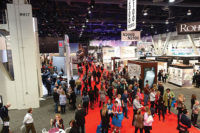Is “universal design” an effective marketing term or would “comfort design” be more acceptable to a wider audience? Will cities of the future have no sewers but find ways to recycle human waste safely?
These were among the questions considered at a Showroom Managers Council Meeting in June hosted by the American Supply Association. The meeting drew showroom managers from New Jersey, Ohio, Texas, Missouri, Massachusetts, Virginia, New York, Indiana and Illinois to learn more about universal design and “going green” from two expert presenters.
Elaine Ostroff, Hon. AIA, director of Access to Design Professions and founding director of Adaptive Environments, and Gunnar Baldwin, water efficiency specialist at TOTO and a charter director of the Alliance for Water Efficiency, were the featured speakers.
Ostroff stressed the importance of choosing the right words to communicate universal design.
“I’m not sure the term universal design [should be] used to market [the products],” she said. “It’s for in-house. People always know when there is a code word like ‘special ed kids.’” Instead, she suggested showroom staff should focus on the comfort and safety of the products for all users rather than labeling them for aging or disabled users.
Baldwin shared his view of the future: Cities with no sewers or buildings with independent waste treatment systems.
“There will be no off-site discharge,” he noted. “We will have learned how to recycle human waste safely.”
In addition, he said, graywater will be the only source of water for landscaping and irrigation. Storm water will be filtered and returned to underlying aquifers. Potable water will be very expensive. Bathrooms will be even more luxurious but more efficient. Wastewater treatment employees will be redeployed to manage and maintain multiple specialized neighborhood systems.
A pre-meeting survey of attendees conducted by ASA found that 75% of the showrooms represented are seeing more interest from customers in fixtures that will provide help for “aging in place” and 73.3% carry products with the WaterSense label.

Elaine Ostroff (L) with Gunnar Baldwin.
Elaine Ostroff on universal design
Gunnar Baldwin on going “green”
For information on future ASA Showroom Manager Council meetings, visit www.asa.net.



